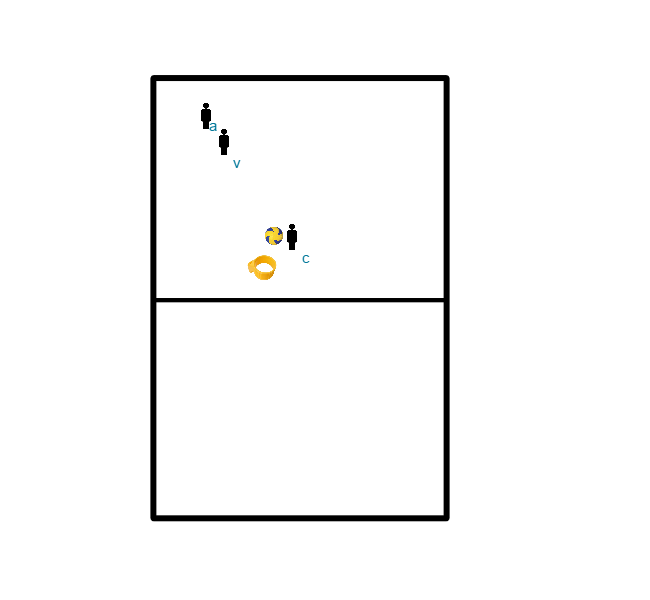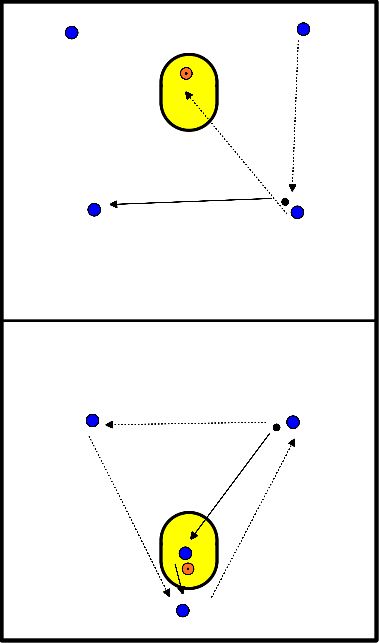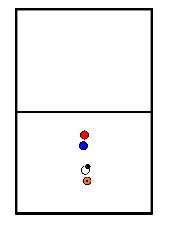Korfball drills
In short: practicing various shooting variations in a fun competition form.
Organization: per group a post and a ball, the posts are preferably (but not necessary) arranged in a circle or rectangle. The number of people per group is less important (but all groups are about the same size).
- The first task for the groups is to score 10 goals.
- When you have completed this assignment, the person who scored the last goal runs to the trainer to pick up the next assignment.
- Which group completed all the assignments first?
- In the meantime, the trainer walks around encouraging or correcting where necessary.
- He has a piece of paper with him with a row of assignments on it. When someone gets to get the next assignment, first ask which one has just been completed (this can vary quite a bit over time) and then give the next assignment.
- An example list: 5 walk-through balls, 5 penalty throws, 5 4-meter shots, 5 walk-through balls from behind the post, 5 shots behind the post.
- 3 men per post.
- Player A starts as attacker for the post.
- Player V starts as defender at 1.5 arm's length from the shooter.
- Player C starts with the ball as catcher/feeder.
- Attacker A must try to score in a 1 to 1 duel.
- It doesn't matter how (distance, dodge, dlb).
- The job of defender V is to follow the attacker continuously at 1.5 arm's length.
- If the attacker has the ball in his hands, the defender must close.
- The defender must not tap or block the balls.
- The V must show that he or she is near the attacker but must allow the shot.
- This can be done by the defender placing her hand just above the attacker's shoulder.
- Switch positions after 1 minute .

- There is someone with a ball under the pole, someone in front of the pole at shooting distance and someone at about 1.5/2 m from the shooter with his face towards the pole.
- The shooter chooses one side and gets the ball.
- The defender is only allowed to turn around when the ball is loose and must therefore respond properly.The defender may not try to block the ball into the pass, but may try to block the shot.
- This can be done as an extension
- To finish the training, play a game format of 4 to 4 on 1 post.
- Make sure you build from 4-0, and go to the 3-1 with a large triangle.
- A quick scoring opportunity has to be created from the big triangle.
- If possible, create a scoring opportunity immediately after the rebound has been captured, if this doesn't work then rebuild from 4-0.
- THE BALL PACE IS HIGH IN THE 3-1.

- Pair of two by a pole.
- Each pole has three points.
- If a score is made on a pole, one point is subtracted.
- The pole is defended by a pair.
- The first pair that has zero gets 'a donkey' as an extra point.
- You lost as a pair when you have zero.
- The last pair remaining has won.
- Note: as a pair you are defending your own post but you can be attacked by six opponents.
- It is not allowed to score twice on the same post.
- Group of 3 by a post
- 1 defender, 1 passer and 1 attacker
- the attacker must score as much as possible in 30 seconds
- the defender must ensure that this happens as little as possible

- 3 attackers against 2 defenders.
- Attack within a radius of about five meters around the post.
- All attackers are allowed to shoot.
- The defenders must try to score as few goals as possible.
- 5 x 1 minute. Skip position after each minute.
- If the number is correct, you can train specific zone defense at this exercise: Zone defensing.
- The defenders let go of their opponents as soon as they get further than six meters from the pole.
- The defender then has only one task: intercepting the ball by picking up the rebound.
- This includes voluntarily letting go of distance through the attack.
- After all, if the ball is not shot, it cannot be caught.
- We play 3:3 or 4:4 around the post without any shot or breakthrough
- Defender only focused on his own opponent.
- You do position yourself in such a way that you can always see the ball but cannot pass the defender over the back side
- The exercise is for the defender to be further away from the defenders if the ball is also far away from the attacker. If the attacker has the ball, the defender makes sure it is connected
- Pairs of two at a pole.
- Each pole has three points.
- If a score is made on a pole, one point is subtracted.
- The pole is defended by a pair.
- The first pair that has zero gets 'a donkey,' as an extra point.
- You are finished when you have zero as a pair.
- The last pair remaining has won.
- Note: as a pair you are defending your own post but you can be attacked by six opponents.
- It is not allowed to score twice on the same post.
- Two players stand 7 meters in front of the post and eight meters apart.
- A player with the ball under the post and a receiver slightly behind the post.
- One player in front of the post takes the through-ball that is passed, after the other player in front of the post has received the ball.
- The ball is caught by the receiver.
- A1 becomes A2,
- A2 becomes A3,
- A3 becomes A4 and
- A4 becomes A1.
What can you see?
- The passer learns that the shooter can only take a through-ball if the throwing is calmly prepared, is thrown in front of the shooter and the ball is passed at the right height.
- The speed and trajectory of the shooter can be regulated by the speed of throwing, ball trajectory and ball speed.
- Learning to control problems such as timing requires a lot of repetition and sometimes adjustment of the distances used.
- The problems for the shooter, the starting position of the ball is different because the body is twisted for ball reception, lead to impure actions. Stay attentive to this.
- The action speed must be increased.
Variant: - Just like exercise 12, but the passer throws the ball to a shooter who dodges to a position diagonally behind the post.
- There is a ball through the centre where the passer must consider two opponents, his direct opponent and the shooter's opponent, as they are not far from the ball line.
Variant: - The marksman makes a feint shot and passes the ball to the player below the post indicating a through-ball.
- Per group: a post and a ball, the posts are preferably (but not absolutely necessary) arranged in a circle or rectangle.
- The number of persons per group is less important (but all groups are about the same size).
- The first task for the groups is to score 10 goals with a through-ball.
- When you have finished with that, the person who scored the last goal runs to the trainer to get the next task. Which group performed all the tasks first?
- The trainer has a piece of paper with tasks on him.
- When someone comes to get the next task, first ask which task has just been completed (this can vary considerably over time) and then give the next task.
- List:
- 5 through-balls,
- 5 penalty throws,
- Five 3-meter shots,
- 5 shots from 3 meters behind the post.
Create a box with an attacker inside.
- The attacker has to keep moving in the box while a defender is running.
- Someone always plays the ball.
- The defender looks at the ball and tries to catch it
- Every time the attacker catches the ball, someone enters the box.
- When the defender picks up the ball, he throws it back and tries again








